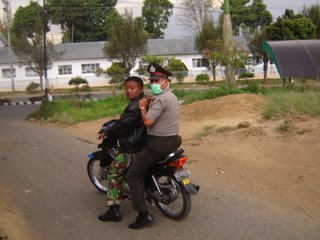Doing The Math

Al, Neil Ferguson’s work with predictive models for disease outbreaks looks very interesting. My understanding of mathematical modeling is really pretty weak, but I understand the models must work by taking into account a set of variables that affect a disease’s potential to spread. Some of those factors must come from the disease itself, and some must come from social conditions of its hosts. His quote from a Guardian article:
"Indonesia is one of the more worrying areas of the world," Prof Ferguson said. "The education of the population is not high.
"Along with sub-Saharan Africa, it is one of the areas of the world to be worried about ... much more so than the occasional case in Europe. Here, we will deal with any outbreak effectively. In Africa, there is almost no control, and there is no monitoring."
I’m going to try to contact him by email and ask some questions about the work.
Here are some factors I’m seeing in Indonesia that may set it apart. I wonder if they can be quantified at all. If they can, are they already part of the modeling?
1. Bird owner’s reluctance to report symptoms among their flock.
2. Higher rates of contact between birds and children. (50 percent of victims so far are children)
3. Central government’s weak or restrained influence on regional government’s policy.
4. Misreporting of the number of destroyed birds in an area due to corruption.
5. Inconsistency in the kind of vaccine used.
6. Black-market sale of ineffective or false vaccine.
7. Lack of funding for public education, compensation, and vaccines.
8. International reluctance to give Indonesia money due to concern about corruption.
9. The deferential role of international agencies such as the WHO and FAO in Indonesia.
10. Strength of a region’s cultural identity and independence from central government.
11. Local bird owner’s distrust of both local and centralized government due to a history of corruption.
12. A lack of observance of standards for the handling of birds during culls.
13. Widespread unregulated trade of birds over long distances – racing pigeons, fighting cocks, and circulation of eating birds as currency.
14. Lack of both perceived and real threat to the population.
15. Lack of general medical care and health maintenance (screening, check ups, entry points for health education)
16. Backyard chickens in an urban megacity environment.

3 Comments:
15. The use of poultry as currency
From my readings I think this is a major factor in disease spread. If birds were converted to cash and the cash moved around, not the birds, containment would be a lot easier.
It seems to me, the number one thing to focus on is compensation. They'll never get the locals on board as long as they're being asked to give up their livelihoods with no tangible benefit to doing so. If it's more advantageous for them to give up their birds than keep them, they'll cooperate. I know that's too simplistic, but in my experience, carrots work better than sticks.
Check it ou homes adirondack wood siding if your building homes go to Http://siding11.com/side.pl?y=helper. butt if you want to learn to install siding then..... What are you waiting for.. Learn more about adirondack wood siding
Post a Comment
<< Home